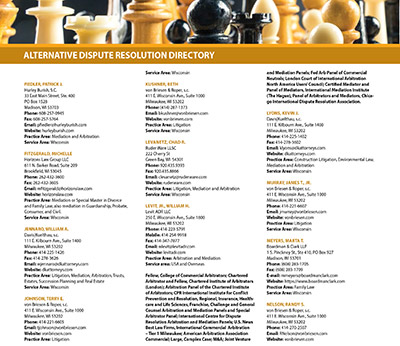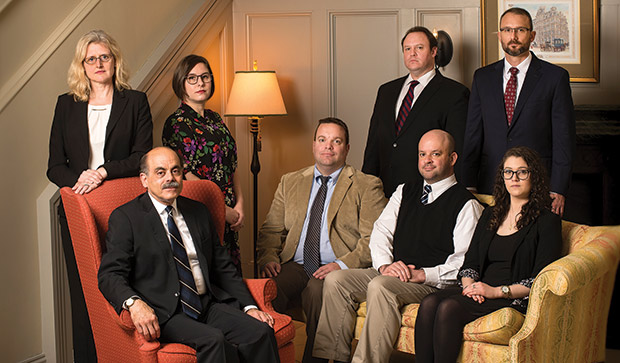VIEW FROM THE HALLWAY: Judge-turned-mediator offers advice on what works
By: Bridgetower Media Newswires//November 26, 2019//
VIEW FROM THE HALLWAY: Judge-turned-mediator offers advice on what works
By: Bridgetower Media Newswires//November 26, 2019//
By Retired Judge Richard J. Sankovitz

Judges are often asked for their views on what works and what doesn’t in the courtroom. This also extends to their thoughts on what persuades them and what persuades juries, and what doesn’t.
Practitioners offer their advice on the subject all the time. Even so, the view of a judge – “a view from the bench” – seems to have a special allure.
John W. Davis, the legendary Supreme Court advocate, explained why: “(S)upposing fishes had the gift of speech, who would listen to a fisherman’s weary discourse on flycasting, the shape and color of the fly, the size of the tackle . . . and all the other tiresome stuff that fisherman talked about if the fish himself could be induced to give his views…?”
I miss the bench, and I miss sharing my views on what works in the courtroom. In the courtroom, judges are treated to the best human drama there is. And judges get the best seat in the house.
But, if you think about it, judges don’t get to see what goes on in the hallway. In fact, at a time when so many cases settle, the real drama rarely reaches the courtroom. And being there for that is one thing I love about my new job. Plus, now I have more to share – a view from the hallway.
A judge could go on at length about all settlement strategies and techniques that bomb, but practitioners who will have read this far are more interested in what they can add to their repertoire, not what needs to be subtracted.
Here are a few mediation strategies and techniques that have impressed me in my first year in this new practice:
- A party that comes to the table prepared with its opening offer as well as its second or third offer will seize the momentum of mediation and demonstrate, at least subconsciously, by how quickly it responds, great confidence in its claims or defenses. Parties who insist on seeing what another party has to offer first, and then take what appears to be a lot of time to think over a response, often signal that they are in denial about their prospects of reaching a settlement, that they haven’t thought through the issues, that they have underestimated their adversary, or all three. I’ve been particularly impressed with parties who come to the table with a spreadsheet showing them instantly how an offer, if accepted, would lead to a property-division award, a payout to (or payment by) partners or LLC members or class members or the like, or the attorney-fee share of the recovery.
- Negotiation can be fruitless if the discussions devolve into a debate. Progress can be stymied if all the parties do in exchanging offers is exchange the same views they exchanged in the courtroom before mediation, such as the positions they advanced in a motion to dismiss that has already been denied or taken under advisement. I’ve been impressed with parties who, instead, frame their offers with a succinct, sympathetic and persuasive explanation for why they think both sides can live with the compromise that is being proposed.
- If a case features two or three exhibits that a judge or jury will spend the most time thinking about – the damning email, the contract clause, the before-and-after photos, the response to the request to admit – arm the mediator with hard copies of those exhibits to show the other side, and in particular the other party, who may not yet have been confronted with the exhibit by his or her lawyers.
- Sometimes judges are too hopeful about or inexperienced with mediation and order a deadline well before the parties are ready to discuss settlement meaningfully. Perhaps a key bit of discovery needs to be completed, or a dispositive motion needs to be decided. Cases ordered to mediation against the instincts of one party or the other often don’t reach settlement, and the sour experience makes it all the harder to broach settlement when the opportunity ripens. I’ve been impressed with parties who find themselves in this situation, who ask a mediator to talk to them about the potential for settlement, and who enlist the mediator to talk to the judge about modifying the mediation deadline.
- Parties who believe they are too far apart to settle and fear that continued effort towards finding a number in the middle will be wasted generally are well served by a conditional offer: if you offer at least x, we will reduce our demand to y. Although such an offer should not be made too early, some parties are afraid to make such an offer at all. In my experience, offers like these – which often prompt equally informative counter-conditional-offers – can pave an efficient way to settlement.
Legal News
- Former law enforcement praise state’s response brief in Steven Avery case
- Eric Toney announces re-election bid for Fond du Lac County District Attorney
- Former Wisconsin Democratic Rep. Peter Barca announces new bid for Congress
- Republicans file lawsuit challenging Evers’s partial vetoes to literacy bill
- More human remains believed those of missing woman wash up on Milwaukee Co. beach
- Vice President Harris returning to Wisconsin for third visit this year
- Wisconsin joins Feds, dozens of states to hold airlines accountable for bad behavior
- Trump ahead of Biden in new Marquette poll
- Bankruptcy court approves Milwaukee Marriott Downtown ‘business as usual’ motion
- New Crime Gun Intelligence Center to launch in Chicago
- Arrest warrant proposed for Minocqua Brewing owner who filed Lawsuit against Town of Minocqua
- Wisconsin Supreme Court justices question how much power Legislature should have
WLJ People
- Power 30 Personal Injury Attorneys – Russell Nicolet
- Power 30 Personal Injury Attorneys – Benjamin Nicolet
- Power 30 Personal Injury Attorneys – Dustin T. Woehl
- Power 30 Personal Injury Attorneys – Katherine Metzger
- Power 30 Personal Injury Attorneys – Joseph Ryan
- Power 30 Personal Injury Attorneys – James M. Ryan
- Power 30 Personal Injury Attorneys – Dana Wachs
- Power 30 Personal Injury Attorneys – Mark L. Thomsen
- Power 30 Personal Injury Attorneys – Matthew Lein
- Power 30 Personal Injury Attorneys – Jeffrey A. Pitman
- Power 30 Personal Injury Attorneys – William Pemberton
- Power 30 Personal Injury Attorneys – Howard S. Sicula









